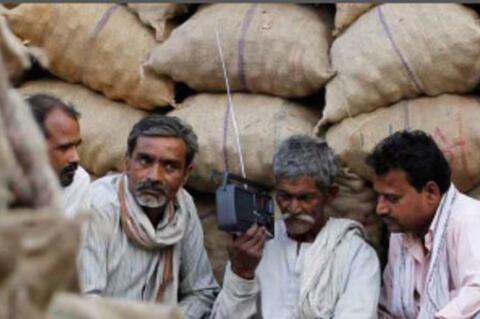Radio Saathi App

"We understood from the very onset that the role of the CR community in the creation of such a learning tool was pivotal..."
The Radio Saathi app is an Android mobile application for multimedia-based training for individuals in India who are interested in running a community radio (CR) station or already running one. Designed for beginners, it consists of 6 comprehensive self-learning modules followed by exercises and quizzes for each module. It further allows for customisation at the CR station level in that it is possible to add/modify the existing modules and include profiles of members. Designed with audio-visual features useful for people with low or no literacy skills, this mobile app has features like offline access to content, analytics, quizzes, and assignments. Indian digital marketing agency MixORG and its partners in the project hope that Radio Saathi will be helpful in engaging more people in CR station operations, as it will impart training on CR basics.
MixORG began the research phase of Radio Saathi by partnering with OneWorld South Asia, who provided reading material and became content advisors for the training material to be given in the mobile application. Together, they came up with a content framework and then took a field visit to Gurgaon Ki Awaaz. With the collective inputs of that station's CR team, MixORG gained further insights into practical problems at the CR station level, which led them to add another module on CR station management in the training curriculum. They observed the day-to-day functioning of a CR station, interacted with the reporters and volunteers, and learned about the training. They conducted a gap analysis, which led them to understand the need for an elementary training curriculum for beginners in CR stations that would introduce them to fundamental principles of CR station functioning.
To develop the framework, with the help of project supporter Development Alternatives, project supporter, MixORG partnered with OneWorld Foundation India, consulting their centralised portal, which is a place for the CR community to find information about events and guidelines from the Ministry of Information and Broadcasting. MixORG then narrowed their list down to 6 basic training areas and developed content in Hindi under the following headings:
- Introduction to Community Radio
- Topic Selection & Radio Formats
- Radio Programme Production
- Post Production (Editing & Mastering)
- Broadcasting & Narrowcasting
- Radio Station Management
Based on a review workshop with various experts in the field on January 16 2015, organisers worked upon further refinement of content for the mobile app and then visited Radio Bundelkhand in Orchha, Madhya Pradesh to validate the existing content framework. This visit led the project team to believe that text or audio in itself would not be sufficient in training the reporters and that more interactivity in the modules was needed. The information presented to the CR reporters through mock videos caught their attention the most and, per them, was the most apt medium for education. Being in the media industry, with whatever limited exposure they had, they understood that entertainment was the clear way to get any kind of message across. Some of them helped record some parts of video voice-overs.
In addition to the decision to use videos to educate, other guiding principles for content development included the importance of self-sustaining training material which could be customised/modified at the CR station level. Thus, the project team chose the PowerPoint model, assuming that people would be somewhat acquainted with the software and could work on it themselves. They also wanted the app to be literacy-neutral; hence, the choice of audio and visuals to make videos seemed obvious. They wanted the CR reporters to self-learn at their own pace and so added a quiz section at the end of each module so that they could evaluate their learning. Through the content review workshop, the team learned from the experts that sometimes overdose of information becomes a deterrent in the learning process of a beginner; therefore, they added additional reading materials as links in each module. The CR community also suggested including some "do's and don't's in each section of the training curriculum.
The project team also constructed a list of specific challenges, which they addressed through a mitigation plan. For instance, they designed the app to be in Hindi, as initially they are partnering with Hindi-speaking CR stations. The app size should be low so that people can download it easily, even with low internet bandwidth connectivity. The app will be available for free download from the Google Play store, although content for the app, primarily videos, would be distributed through micro-SD cards, which can be easily inserted into almost every android phone. The app would have an easy mobile number login method so that people could track individual progress within the app. The videos would be created through PowerPoint so that later the CR stations can edit/add/modify it easily. They would follow a simple folder structure in the SD-card for the content distribution so that files could be easily read through correct names and numbering. Through a competition, CR stations would be included in the design of icons used within the app to give the community sense of ownership within the app, other than having their views and consensus on the topics included initially. (With the help of OneWorld, MixORG reached out to the various CR stations across India and invited icon ideas from everyone for the 6 modules. The 2 winners were announced during the 5th National Community Radio Sammelan held March 16-18 2015 in Vigyan Bhawan, New Delhi.) They planned to provide a training video to the CR station on how to edit the content within the app and also guide them in doing it in a workshop. They would also add a profile section within the app that is completely editable and which will reflect the names and photographs of the CR station team members so that they have a sense of belonging and deeper connect with the training provided.
The project team understood from the very onset that the role of the CR community in the creation of such a learning tool was pivotal; therefore, they explored different methods to include them in the co-creation of the mobile application, such as the icon design contest described above. With the help of Development Alternatives, MixORG partnered with 5 (primarily Hindi-speaking) CR stations. At a March 19 2015 workshop, the project team asked the CR stations about their existing training methods and then demonstrated the mobile app to them. They mapped their suggestions and made changes to the icons, the launch screen, etc. Those present voted on the name of the app and agreed on Radio Saathi. After several rounds of video editing, sound syncs, and text updates, the developers incorporated the changes within the app with all the new icons and visual language. On April 17 2015, they published the Radio Saathi app on the Google Play Store. It is available in public domain for free use with licensing of content as creative commons (CC-SA).
Also thinking about the requirement of adaptability, the project team pre-ordered a few micro-SD cards to be distributed to the partnering CR stations and other stakeholders, while also preparing a comprehensive chart and demo video of the folder structure and how it could easily be modified by the CR stations. The micro-SD card has the content folders and also the mobile app apk file. On it is a link to the Radio Saathi web-page where people could get more information about the project and send in their queries.
As a round-up to the entire project, the project team organised an application usability and feedback workshop with the 5 partnering CR stations. In this workshop, the participants started by downloading the app for free from Google Play store and then were given the content through the micro-SD card, which they could completely customise to suit the needs of their station right then and there. The project team then gave them a live demo as to how they could change the CR station logo and profile of members and also check their individual progress within the app. Then, there was a feedback session primarily about the usability of the app; people had suggestions which are possible to implement at the CR station level given the open-source nature of the application. The general feedback was very positive, and the reporters were pleased that they themselves were able to make changes on the computer and see them directly reflected in the application without any coding or programming required.
Community Radio
In India, CR stations are expected to produce at least 50% of their programmes locally and as far as possible in the local language or dialect. The stress is on developmental programming, and news programmes are banned. It is noted that CR in India has come a long way since the first campus radio station began its operations in 2004; as of April 2015, there were 195 registered CR stations in India. Activists and community workers from across the country have banded together under the aegis of the "Community Radio Forum" in order to coordinate training and support for CR stations, as well as to continue to petition for a more proactive CR policy.
A rough estimate shows that CR stations in India broadcast their content in at least 57 languages and dialects. The biggest challenge in developing this app was to ensure that it remains highly customisable and user-friendly. Hence, it needed to be developed in such a way that the icons, navigation text, narration, animations, and content can be changed by the user based on its requirement.
MixORG, Development Alternatives, One World South Asia
"Bridging the Digital Divide: Technological Innovations and Content Development for Community Radio - Project Report 'Radio Saathi'" [PDF], 2015; and posting by Tej Prakash to the Community Media Network on The Communication Initiative platform, April 30 2016.
Comments

DOWNLOAD RADIO SAATHI APP
How can we dowload this in Uganda and use it. We have also discussed the idea of getting and audience research app for CR on mobile could you assust with this.
- Log in to post comments
